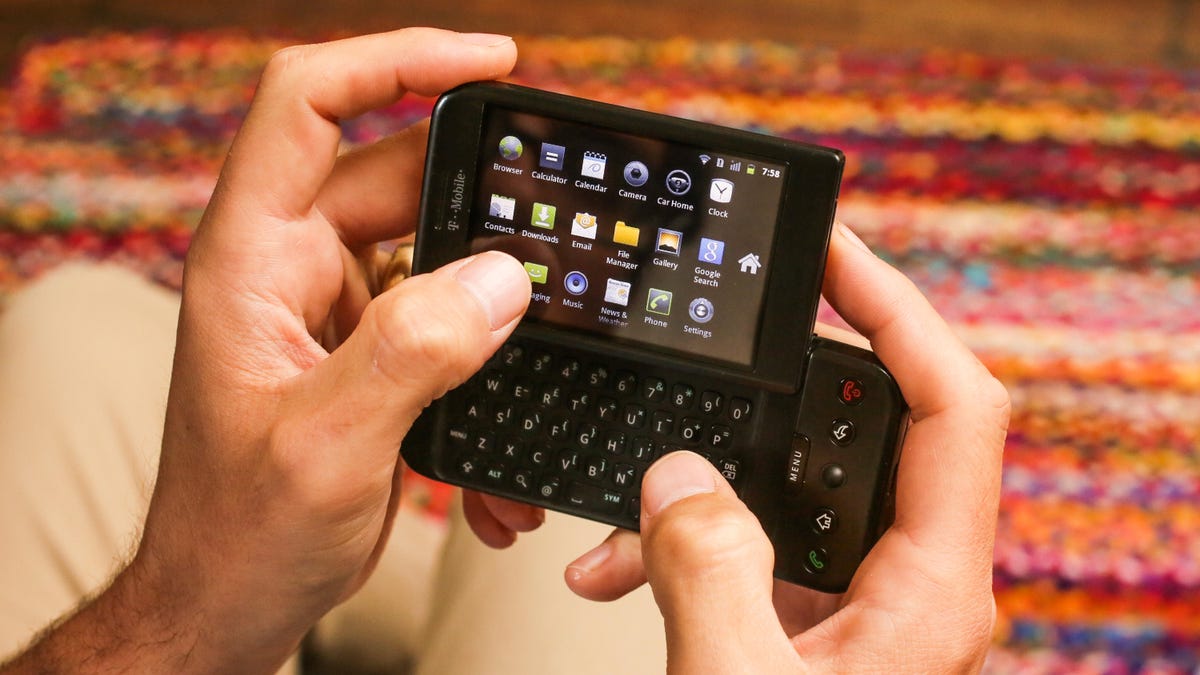Android's first phone, the T-Mobile G1, almost looked like a BlackBerry
And six other things you probably didn't know about the original Android smartphone.

The T-Mobile G1 could've had a much different look.
The T-Mobile G1 is an iconic device. But with its slide-out full QWERTY keyboard and a thick chin, it isn't an attractive one.
When it debuted a decade ago, the original Android smartphone was seen as a bulky, awkward product. Critics loved the slick Android operating system it ran, but the hardware didn't prompt the universal praise its contemporary, the original iPhone , did.
"G1 is definitely not the sleekest device, and we certainly wouldn't call it sexy," CNET's review said at the time. "Instead, the words 'interesting' and 'weird' come to mind."
Time has been kind to the G1. Stacked up next to the iPhone XS Max and Galaxy Note 9, the G1 looks positively cute. That odd chin gives it a distinct look in today's sea of plastic and metal slabs.
But that wasn't the original look of the G1. When HTC and Google worked together to build the first Android phone, the companies initially developed a design that looked a lot like a BlackBerry , with a small, squarish screen on the top half and a physical keyboard on the bottom.
That's just one of the tidbits shared by Peter Chou, HTC's former CEO and the man who spearheaded the development of the G1 alongside Andy Rubin, who was the Google executive in charge of Android at the time. I talked with Chou for the 10th anniversary of the G1 about what went into the development of the phone. (Google declined to be interviewed.)
Here are a few things you probably didn't know about the G1.
A BlackBerry-like G1
The original prototype for the G1 didn't have a slide-out keyboard, like the one on the T-Mobile Sidekick , Chou said. The first design called for a phone that looked a lot like a larger BlackBerry 5000 series phone.
It's the T-Mobile Dash.
A spokeswoman for Rubin confirmed there were two devices in parallel development, with the first, codenamed Sooner, using the body of the HTC Excalibur (known as the T-Mobile Dash, which ran the Windows Mobile operating system and came out in 2006).
Chou referred to the phone as the Dash.
Sooner was used for internal development, with the idea that it could ship "sooner" if necessary. The phone didn't have a touchscreen.
The move was logical, given the popularity of those BlackBerrys among the corporate set at the time.
Dream was the second device. Because it featured a new design and touchscreen, it'd require more development time. Given the aspirational vibe of that option, one can guess the meaning behind the name.
The Android team obviously went with the more ambitious G1 design.
HTC almost built the Sidekick
Chou said his first interaction with Rubin came when HTC and Danger, Rubin's original company, were in talks to build the Sidekick phone.
It didn't work out. Sharp ultimately won the deal.
A deal over dinner
After Rubin moved from Danger to founding Android Inc., one of his co-founders, Rich Miner, set up Chou and Rubin for a dinner in Barcelona during Mobile World Congress more than a decade ago to talk about the future of smartphones. Chou, who worked with carrier partners all over the world, knew Miner from his previous stint at French telecom giant Orange, and Miner thought the two should meet.
Chou and Rubin hit it off immediately.
"We discussed the vision of how we could make the mobile internet experience so much easier for mass-market consumers," Chou said, noting they both shared a frustration that the smartphone user experience was still clumsy. At the time, many smartphone operating systems , like Windows Mobile, required a stylus or really tiny finger, and only the iPhone offered a full web browser.
That dinner turned out to be critical
A few months later, Google acquired Android. The search giant created the Open Handset Alliance, a group designed to advocate for the new platform and rally different handset makers and carriers behind it. But Rubin said he'd continue to work with HTC.
Even as bigger names like Motorola later jumped on board, Rubin insisted that HTC would be the launch partner because of that early work.
That would end up being a huge deal for HTC, which largely built phones carrying other brand names. The G1 smartphone would help catapult the HTC brand into the public eye.
The first Android phone took a year to get right
Chou sent around 50 HTC engineers to live in Mountain View, California, so they could work alongside Google's team. The reason was the desire to have the software and hardware work seamlessly together.
The G1 was always meant for Android.
"It was a great working partnership experience," Chou said. "And we didn't disappoint."
That may explain why HTC was among the first to re-skin Android, offering the more attractive HTC Sense user interface on top of the operating system. It also unwittingly would portend the move of many HTC employees to Google to work on the Pixel franchise in a $1 billion deal struck last year.
The Dream was always for Android
Chou insists the Dream prototype was always meant for the G1. Given the similar design cues and materials, there's always been speculation that the hardware was first intended for another Windows Mobile device.
It's no iPhone copycat. Really
Despite Apple kicking off the wave of modern smartphones, Chou denied the iPhone had any influence in the development of the G1.
"We were working on this since before the iPhone launch," he said. "We didn't just see the iPhone and decide to do something like that."
Pixel 2 review: It still has an amazing camera, but its follow-up is expected soon.
Pixel 3 and Pixel 3 XL: Rumored specs, features, leaks and released date

